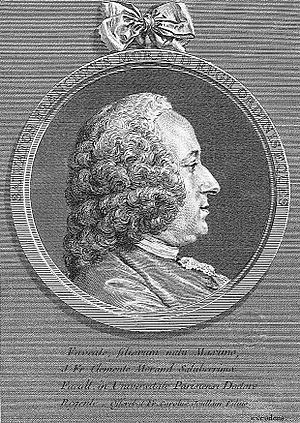Sauveur François Morand facts for kids
Sauveur François Morand (born April 2, 1697, in Paris; died July 21, 1773) was an important French surgeon. Surgeons are doctors who perform operations to fix injuries or diseases.
Contents
Sauveur Morand's Career
Sauveur Morand started his career in 1724. He became a teacher of surgery at the Jardin du Roi in Paris. This was a famous garden that also had places for scientific study.
He later worked as a surgeon at the Hôpital de la Charité starting in 1730. He also became the main surgeon for the Régiment des Gardes françaises in 1739. Later, he was the chief surgeon at the Hôtel des Invalides, a hospital for soldiers.
Joining Important Groups
Morand was a founding member of the Académie de chirurgie (Academy of Surgery) in 1731. This was a very important group for surgeons in France. He was also a member of many other scientific groups across Europe.
In 1725, he was chosen to be a member of the Académie Royale des Sciences (Royal Academy of Sciences). This showed how respected he was in the world of science.
Learning New Surgery Techniques
In 1729, Morand visited St. Thomas's Hospital in London. There, he learned a new way to remove bladder stones from a famous surgeon named William Cheselden. This procedure was called lateral perineal lithotomy. It involved filling the bladder with water before the operation.
While he was in England, he was also made a Fellow of the Royal Society. This is another very old and respected scientific group.
Discovering a New Condition
In 1766, Sauveur Morand wrote about a child who was missing their collarbones. This was the first time anyone had described this condition. Today, we call it cleidocranial dysostosis. It is a rare genetic disorder that affects bones and teeth.
Morand's Family Life
Sauveur Morand came from a family of surgeons. His father, Jean Morand (1659-1726), was also a chief surgeon at the Hôtel des Invalides.
Sauveur Morand married the daughter of Georges Maréchal. Georges Maréchal was the main surgeon for two French kings, Louis XIV and Louis XV.
Sauveur's son, Jean François-Clément Morand (1726-1784), followed in his family's footsteps. He taught classes on anatomy (the study of the body's structure) and obstetrics (the care of women during pregnancy and childbirth).
Morand's Spur
Sometimes, a part of the brain is named after a person who first described it. "Morand's spur" is one such example. It is a small bump found inside a part of the brain called the lateral ventricle. This bump is caused by a fold in the brain called the calcarine sulcus. It is sometimes also called "Haller's unguis."


